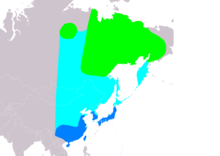Baikalente
| Baikalente | ||||||||||||
|---|---|---|---|---|---|---|---|---|---|---|---|---|

Baikalerpel ( Sibirionetta formosa ) |
||||||||||||
| Systematics | ||||||||||||
|
||||||||||||
| Scientific name of the genus | ||||||||||||
| Sibirionetta | ||||||||||||
| Boetticher , 1929 | ||||||||||||
| Scientific name of the species | ||||||||||||
| Sibirionetta formosa | ||||||||||||
| ( Georgi , 1775) |
The Baikal duck ( Sibirionetta formosa , syn .: Anas formosa , Nettion formosum ), also called the gluck duck , is an Asian duck bird (Anatidae). The distribution area extends from northeast Siberia to the Kamchatka peninsula. In its splendid plumage, the male has a very contrasting coloration. This is also indicated by the scientific species name, formosa means beautiful.
features
The Baikal duck has a height of 30 to 40 cm and a length of 40 to 43 cm. It weighs around 500 g.
The Baikal Duck is a small gudgeon duck , the elongated body with long hand wings and the strong and long beak are striking. Drake and duck have different color images. While the drake stands out with its brightly colored head in green, black, yellow and white, the duck is characterized by a white patch on the cheek. In the drake, the individual color areas are clearly separated from one another. The chest has a warm, yellow-brown tone. The flanks are gray. The shoulder feathers are elongated and are red-brown, cream-colored and black. They fall conspicuously over the sides of the body.
The female resembles the other females of the genus of real ducks . Apart from the characteristic light spot on the cheek, it also differs in the darker dots, which are particularly noticeable on the flanks. A crescent-shaped black stripe runs through the eye and a dark eye stripe also runs to the nape of the neck.
Occurrence
Baikalenten can be found during the summer mainly on the banks of large Siberian rivers at not too high altitudes, the main wintering areas, however, are the lakes in Japan and the People's Republic of China . The moult sets in in July . Some drakes move to the Arctic Ocean for this , others stay in the breeding area.
Baikalenten overwinter in southern Japan as well as in eastern China and Taiwan. Some Baikalents also reach Assam and northern India during their winter migration.
Since 1840, the year it was first imported, it has also been kept as a breeding duck in Europe.
nutrition
The Baikal teal feeds on small animals and plants they attach dabbling filter out.
Reproduction
The Baikalente is a common breeding bird in Eastern Siberia, it can be found in swamps , floodplains and river deltas . After mating in mid-May, the nests are quickly built in the bank grass, hidden under branches. For this, hollows are dug and covered with down . The clutch consists of seven to nine green-gray eggs. The female breeds alone. The male moves to the moulting areas while the female is breeding. After about 26 days, the young ducklings hatch with a weight of 30 g.
Hazard and protection
The Baikalente was once one of the most widespread and common ducks in Asia. However, the distribution area and the population numbers fell sharply due to intensive hunting and habitat loss. Currently, the population size increases again, the Baikal teal applies on the red list of the IUCN (Version 2013.2) as not endangered ( Least Concern ).
supporting documents
literature
- John Gooders and Trevor Boyer: Ducks of Britain and the Northern Hemisphere . Dragon's World, Limpsfield 1986, ISBN 1-85028-022-3 .
- Richard Sale: A Complete Guide to Arctic Wildlife . Christopher Helm, London 2006, ISBN 0-7136-7039-8 .
Web links
- Sibirionetta formosa onthe IUCN Red List of Threatened Species .
- Videos, photos and sound recordings of Sibirionetta formosa in the Internet Bird Collection
- Avibase Dataset Grouch Duck ( Anas formosa )
Single receipts
- ↑ Sale, p. 16

